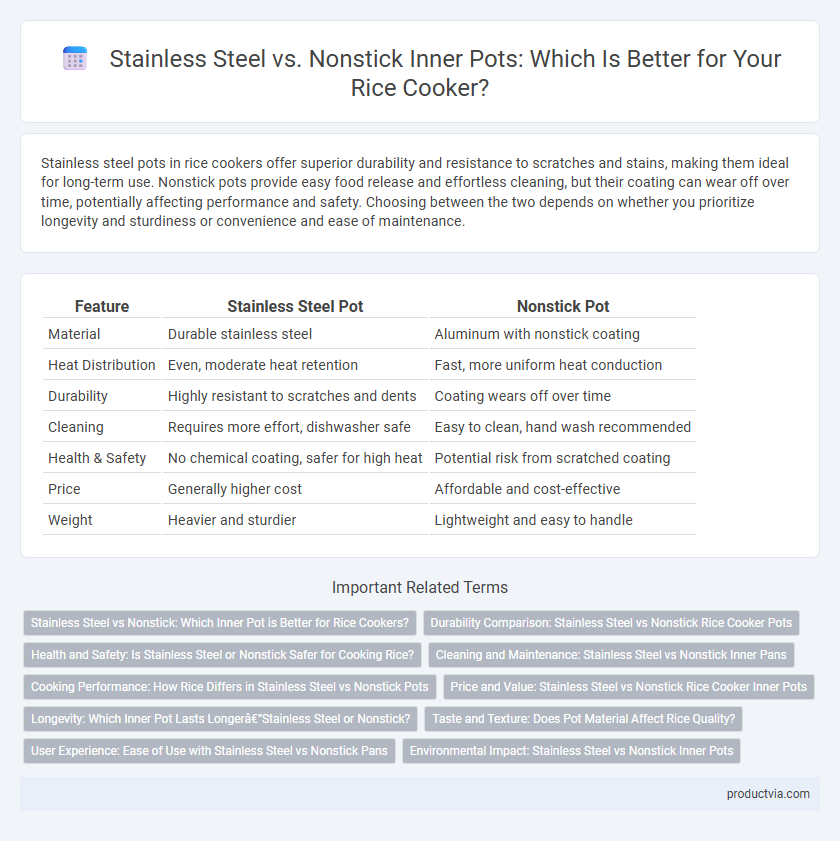Stainless steel pots in rice cookers offer superior durability and resistance to scratches and stains, making them ideal for long-term use. Nonstick pots provide easy food release and effortless cleaning, but their coating can wear off over time, potentially affecting performance and safety. Choosing between the two depends on whether you prioritize longevity and sturdiness or convenience and ease of maintenance.
Table of Comparison
| Feature | Stainless Steel Pot | Nonstick Pot |
|---|---|---|
| Material | Durable stainless steel | Aluminum with nonstick coating |
| Heat Distribution | Even, moderate heat retention | Fast, more uniform heat conduction |
| Durability | Highly resistant to scratches and dents | Coating wears off over time |
| Cleaning | Requires more effort, dishwasher safe | Easy to clean, hand wash recommended |
| Health & Safety | No chemical coating, safer for high heat | Potential risk from scratched coating |
| Price | Generally higher cost | Affordable and cost-effective |
| Weight | Heavier and sturdier | Lightweight and easy to handle |
Stainless Steel vs Nonstick: Which Inner Pot is Better for Rice Cookers?
Stainless steel rice cooker inner pots offer superior durability, resistance to scratches, and non-reactive surfaces that maintain food flavor and safety over time. Nonstick pots excel in easy cleaning and prevent rice from sticking, but their coating can wear off, potentially reducing lifespan and raising health concerns if scratched. Choosing between stainless steel and nonstick depends on prioritizing longevity and food purity versus convenience and effortless cleanup.
Durability Comparison: Stainless Steel vs Nonstick Rice Cooker Pots
Stainless steel rice cooker pots offer superior durability, resisting scratches, dents, and high temperatures without degrading over time. Nonstick pots provide convenience with easy food release but tend to wear out faster due to coating peeling and scratching. Choosing stainless steel ensures long-lasting performance and robust resistance to everyday cooking wear.
Health and Safety: Is Stainless Steel or Nonstick Safer for Cooking Rice?
Stainless steel pots for rice cookers offer high durability and resistance to scratching without releasing harmful chemicals, making them a safer choice for health-conscious cooking. Nonstick pots, while convenient for easy cleaning, may pose risks if the coating degrades at high temperatures, potentially releasing toxic fumes or flakes into food. Choosing stainless steel ensures chemical-free cooking and easier maintenance of the inner pan's safety and integrity over time.
Cleaning and Maintenance: Stainless Steel vs Nonstick Inner Pans
Stainless steel inner pots for rice cookers offer superior durability and resist staining, allowing for rigorous cleaning methods such as scrubbing with abrasive pads or dishwasher use without damage. Nonstick inner pans require gentle cleaning with soft sponges and mild detergents to maintain the coating and prevent flaking, limiting their longevity under frequent heavy use. Choosing stainless steel enhances long-term maintenance efficiency, while nonstick pots provide ease of initial cleaning but demand more careful upkeep to avoid deprecation.
Cooking Performance: How Rice Differs in Stainless Steel vs Nonstick Pots
Stainless steel pots for rice cookers offer superior heat retention and even distribution, resulting in more consistent cooking and fluffy rice texture with less risk of burning. Nonstick pots, by contrast, provide easy release and cleanup but may produce slightly less evenly cooked rice due to thinner material and faster heat dissipation. Choosing between stainless steel and nonstick inner pans affects cooking performance, with stainless steel enhancing heat conductivity for precise rice cooking while nonstick prioritizes convenience.
Price and Value: Stainless Steel vs Nonstick Rice Cooker Inner Pots
Stainless steel rice cooker inner pots often come at a higher price point but offer superior durability and resistance to scratches and corrosion, providing long-term value. Nonstick inner pots are generally more affordable and offer easy food release and cleaning, but they may wear out faster and require replacement over time. Choosing between stainless steel and nonstick depends on balancing upfront cost with longevity and maintenance needs.
Longevity: Which Inner Pot Lasts Longer—Stainless Steel or Nonstick?
Stainless steel inner pots in rice cookers offer superior longevity due to their resistance to scratches, dents, and corrosion compared to nonstick pots which tend to degrade and peel over time. Nonstick coatings typically wear off within 1-3 years depending on usage and maintenance, whereas stainless steel pots can last a decade or more with proper care. The durability of stainless steel makes it a more cost-effective and sustainable choice for long-term rice cooker use.
Taste and Texture: Does Pot Material Affect Rice Quality?
Stainless steel pots for rice cooker inner pans provide a slightly firmer texture and more natural rice flavor due to their high heat conductivity and lack of coatings. Nonstick pots tend to yield softer, stickier rice with a more uniform texture as their surface prevents rice grains from adhering and burning. The choice between stainless steel and nonstick directly influences the taste and texture by affecting moisture retention and heat distribution during cooking.
User Experience: Ease of Use with Stainless Steel vs Nonstick Pans
Stainless steel pots in rice cookers offer durability and resistance to scratches, making them easy to clean and maintain for long-term use. Nonstick pots provide effortless rice release and quick cleanup, reducing the need for oil and preventing sticking during cooking. Users often find stainless steel pans require more careful cleaning, while nonstick surfaces enhance convenience and speed in everyday rice preparation.
Environmental Impact: Stainless Steel vs Nonstick Inner Pots
Stainless steel inner pots for rice cookers offer superior environmental benefits due to their durability and recyclability, reducing waste over time compared to nonstick pots, which often contain synthetic coatings like PTFE that can degrade and release harmful chemicals during production and disposal. Nonstick inner pans typically have a shorter lifespan, leading to more frequent replacements and increased material consumption, negatively impacting environmental sustainability. Choosing stainless steel pots supports eco-friendly kitchen practices by minimizing chemical pollution and promoting resource efficiency.
Stainless steel pot vs nonstick pot for rice cooker inner pan Infographic

 productvia.com
productvia.com